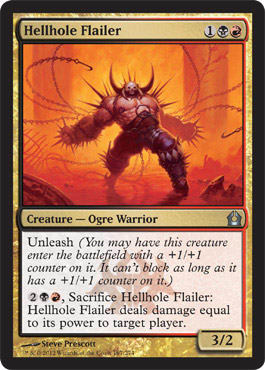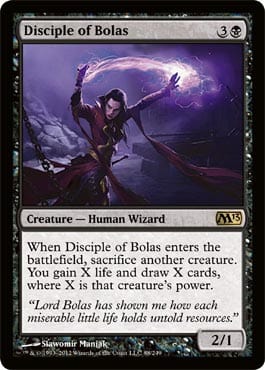You’ve heard of Combo Winter? I propose Aggro Autumn. Return to Ravnica gives each guild chic and sleek early drops, and it would be a shame to waste them. I’ve made a Standard-legal deck for each guild to flex its red-zone muscles. The specific cards matter less than the deck’s direction; you should be able to approximate these decks not long after the set comes out, and some tweaking could bring them to Friday Night Magic caliber if you desired. The more you experiment with new cards, the earlier you’ll discern what works, and that’s vital for a set like this one where everything looks good.
Some guidelines for each deck:
- No mythic or card costing more than $5. If you pick up some of the pricey ones—like Dreadbore or Abrupt Decay—you don’t need these lists to tell you they’re good and to include them.
- Each deck has twenty-three lands. I don’t specify the lands because your budget might support Guildgates, shock lands, or some of both. It’s better for me to make these lists cheap and for you to build them up than for me to require flash and panache.
- Each deck has four of the relevant guild charm. This is not only for utility; using the charms is also cheaper than building your deck up with rares. If there’s one group of cards you’d be foolish not to buy from the new set, it’s the charm cycle. Commons will be plentiful, and rares and mythics might evade your budget. You’ll use the uncommon charms somewhere, and opening random boosters won’t be enough to find a play set. Make sure you buy the charms.
Aggro wants to stop talking and start swinging. Go!
Azorius
"Early Birds"
- Creatures (25)
- 2 Mindshrieker
- 3 Stitched Drake
- 4 Angel of Jubilation
- 4 Arctic Aven
- 4 Judge's Familiar
- 4 Lyev Skyknight
- 4 Welkin Tern
- Spells (12)
- 4 Azorius Charm
- 4 Dramatic Rescue
- 4 Favorable Winds
When I build aggressive decks, I lean toward a highly evasive component. If I’m going to be the beatdown, I want some guarantees on that beatdown. An all-flying deck definitely qualifies, and Favorable Winds gives a build-around incentive. Favorable Winds plus Angel of Jubilation should give you at least one anthem effect most games, and the sooner you can assemble an army for them, the better.
Along the way, there’s the utility of Judge's Familiar, the tempo swings of Lyev Skyknight, Azorius Charm, and Dramatic Rescue, and plenty of incidental life-gain. Stitched Drake encourages aggression with your early drops and trading, with Judge's Familiar providing easy fodder for the Drake. (Besides, you’d want to sacrifice the Familiar before Angel of Jubilation wasted the activated ability.) I’m a huge fan of Mindshrieker in several decks; not only is it an early body with late-game power, but it lets you advance the game even when you’re mana screwed. I’ve nearly won a Standard game while stuck on two lands against an Unburial Rites deck because I milled its largest creatures.
Fly over things, pressure with bounce, and kill opponents before Silklash Spider shows up. It’s kid-tested, Isperia-approved.
Izzet
"Werewolves of Ravnica"
- Creatures (25)
- 2 Village Ironsmith
- 3 Dungeon Geists
- 4 Hanweir Watchkeep
- 4 Instigator Gang
- 4 Kruin Outlaw
- 4 Nivmagus Elemental
- 4 Reckless Waif
- Spells (12)
- 2 Brimstone Volley
- 3 Blustersquall
- 3 Geistflame
- 4 Izzet Charm
Werewolves love instants. You can build to transform your creatures without losing board position, and when you succeed, you have big creatures and a major advantage. I had built a version of this for FNM with the set of Werewolves and Dungeon Geists above, centering the instants around Mana Leak; a first-turn Reckless Waif followed by Mana Leaking the second-turn play was a fun way to get started with damage.
Mana Leak’s rotating, but Izzet Charm substitutes nicely. Like many red decks, the 1-drops are pivotal—Nivmagus Elemental replaces Spikeshot Elder—but the later creatures can get the job done as well. Transformed, a Kruin Outlaw and Instigator Gang combine for lethal, evasive damage. Kruin Outlaw in particular loves an aggro-tempo game, as the opponent’s attempts to stabilize (“Yay! I have two creatures!”) are undone simply when you kill his smallest creature. This isn’t normally available to red decks, as a huge opposing dude is often the beginning of the end.
In one playtest with the deck style, I threatened lethal damage involving Terror of Kruin Pass, but my opponent felt okay with a board of Sigarda, Host of Herons and Thalia, Guardian of Thraben. I top-decked a Pillar of Flame, spent ![]()
![]() to take out Thalia, and slew my opponent while Sigarda watched helplessly. That was even more fun than it sounds.
to take out Thalia, and slew my opponent while Sigarda watched helplessly. That was even more fun than it sounds.
Blustersquall is normally not what I’d choose over Sleep, but being an instant is important, and the regular mode is relevant with Terror of Kruin Pass’s abilities. Similarly, I prefer Pillar of Flame to Geistflame, but Geistflame has the advantage in this version—it's nearly as useful early, but it is prime Nivmagus Elemental fodder on flashback.. The deck might not look right on paper, but believe me: It can be vicious, and it’s loads of fun.
Rakdos
"I don’t do tactics. I don’t do guard duty. I do damage. Take it or leave it."
- Creatures (27)
- 3 Hellhole Flailer
- 4 Dead Reveler
- 4 Desecration Demon
- 4 Diregraf Ghoul
- 4 Rakdos Cackler
- 4 Splatter Thug
- 4 Thrill-Kill Assassin
- Spells (10)
- 2 Tribute to Hunger
- 4 Rakdos Charm
- 4 Pillar of Flame
Speaking of vicious . . . unleash being a mechanic implies that it’s worth investigating. This was not a hard deck to make—jam the best available creatures together—but there are a few decisions worth explaining.
Creature power is far from the only consideration in making it through combat; if a creature lacks evasion, some abilities at least can discourage blocking. Gore-House Chainwalker would be a 3/2 for ![]()
![]() in this deck; that’s pretty cool. But Thrill-Kill Assassin as a 2/3 deathtouch for
in this deck; that’s pretty cool. But Thrill-Kill Assassin as a 2/3 deathtouch for ![]()
![]() is more likely to push through because it’s harder to trade with, that third toughness coming in handy. Besides, choosing the Assassin over the Chainwalker (or Crimson Muckwader) makes all our early drops black. When you can build an aggro deck toward a natural consistency, it’s almost always right to do so, and Thrill-Kill Assassin gives that consistency.
is more likely to push through because it’s harder to trade with, that third toughness coming in handy. Besides, choosing the Assassin over the Chainwalker (or Crimson Muckwader) makes all our early drops black. When you can build an aggro deck toward a natural consistency, it’s almost always right to do so, and Thrill-Kill Assassin gives that consistency.
Desecration Demon has generated mixed reactions in the player base. This deck uses it well. Ideally, by the Demon’s arrival, the unleashed have dealt enough damage to the point that the opponent can’t afford a Demon swing, at which point it’s forcing creature sacrifice every turn. The deck’s removal suite—Tribute to Hunger and Pillar of Flame—clears the way cheaply for your unleash creatures, but it also synergizes with Desecration Demon just as the Izzet deck above mixes removal with Terror of Kruin Pass; if you leave the opponent nothing small to sacrifice to the Demon, it will hurt. The Demon’s weak if you haven’t given it the proper foundation, but so many aggressive creatures minimize the downside.
Hellhole Flailer is in as a backup Rakdos Charm. And I loooove Rakdos Charm. It looks like a sideboard card to some, but to me, it’s a build-around. Each creature dealing 1 damage to its controller is an unusual ability, and its variants, excepting Netherborn Phalanx, are too narrow for regular use. Rakdos Charm has two modes besides burn, but that burn being instant pushes it above its predecessors because it punishes attempts to stabilize at the height of that stability. Let’s say you have three unleashed Dead Revelers, and a Selesnya player’s at 4 life with three blockers: a Loxodon Smiter, a 3/3 Centaur token, and Trostani, Selesnya's Voice. If you swing, Selesnya’s likely to make a third Centaur, gain 3 life, use the tokens to double-block a Dead Reveler, let Loxodon Smiter block a second, and let the third through.
If you have Rakdos Charm in your hand, the Selesnya player’s dead. When Trostani populates, you can respond to the life-gain trigger by hitting the opponent for 4 damage now that said opponent has four creatures. That’s a hand-picked scenario, but it’s an example of how Rakdos Charm can win otherwise stalled games. You always can burn when it’s most advantageous, making it the best version of the effect and a potent damage source.
Golgari
"Morbid Rancor"
- Creatures (28)
- 4 Corpsejack Menace
- 4 Deadbridge Goliath
- 4 Disciple of Bolas
- 4 Dreg Mangler
- 4 Gatstaf Shepherd
- 4 Strangleroot Geist
- 4 Ulvenwald Bear
- Spells (9)
- 1 Hunger of the Howlpack
- 4 Golgari Charm
- 4 Rancor
I’m not entirely sure how to build this deck. What it most wants to do is curve Strangleroot Geist into Rancor into Disciple of Bolas. Morbid, scavenge, and Rancor give the deck several reasons to attack as a bluff for pushing through. If your creatures don’t mind dying, it might be better to leave them on the board in their smaller forms—like an improved bushido. (Okay, I set the bar low.)
The early creatures try to maximize power for mana primarily for Disciple of Bolas, but it’s not a bad idea anyway. Gatstaf Shepherd is a pet card of mine; 3/3 intimidate on its night side can arrive early, and with a Rancor, you’re threatening a quick game.
If Corpsejack Menace were smaller, I wouldn’t have included it, but it’s fine enough for this deck’s goals even if you don’t get the counters going. With the counters, it doesn’t take much synergy to make a difference. A late-game morbid Ulvenwald Bear with Corpsejack Menace will do wonders; the other synergies are generally slower but more powerful.
Of all five decks, I think this one has the most potential but the worst initial build. If you make a good version of this, let me know. I like all the cards, and maybe I’m underestimating Disciple of Bolas’s ability to win with card advantage, but for now, this one’s mostly an idea.
Selesnya
"Brought to you by the letters G and W and by the number 3."
- Creatures (24)
- 4 Arbor Elf
- 4 Avacyn's Pilgrim
- 4 Centaur Healer
- 4 Cloistered Youth
- 4 Loxodon Smiter
- 4 Wolfir Avenger
- Spells (13)
- 4 Selesnya Charm
- 2 Predatory Rampage
- 4 Call of the Conclave
- 3 Collective Blessing
This deck has sixteen 3/3s counting Cloistered Youth and four 4/4s in Loxodon Smiter. Every creature in the deck costs no more than 3 mana. The creature pump gives +3/+3 to the team. You can’t get more three-centric than that.
The key to this deck is having so many similarly sized, efficient creatures. Apart from your ramp, you don’t have to play out your threats in any particular order. You just play variants of the same creature until you draw super-sizers.
While the creatures have little strategy, it is crucial to choose the right mode for Selesnya Charm every time. An all-3/3 deck is very excited to exile a large creature, but sometimes, the +2/+2 will be the right call. The token’s probably only correct the turn before Predatory Rampage or Collective Blessing, both of which are finishers in different ways. The split between them is in part for curve and in part because the Rampage’s swarm-killing complements Selesnya Charm’s exile mode.
No, the deck won’t ever be exciting, but it looks to be incredibly reliable. If you want to swing for 3, the Selesnya have you covered.
Five Shades of Red (Zone)
If you want to swing fast and hard this autumn, every guild has something to offer you. The new spot removal is very efficient, but the board wipe isn’t quite as good—or at least as deep—coming up. It’s time to swing early and often. Sometimes, you build chunky midrange decks that will bob and weave in multiplayer, but sometimes, you just need to smash all of the faces, and whether that’s against friends or FNM enemies (FNMies?), you have a wealth of options coming up.


























